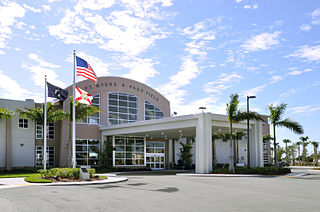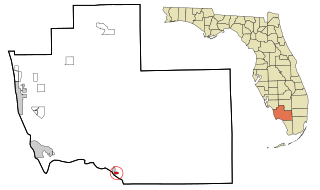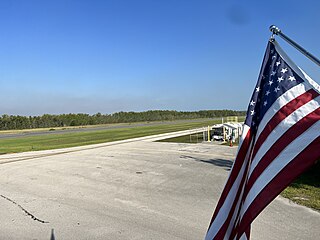
Glades County is a county located in the Florida Heartland region of the U.S. state of Florida. As of the 2020 census, the population was 12,126, making it the fourth-least populous county in Florida. Its county seat is Moore Haven.

Hendry County is a county in the Florida Heartland region of the U.S. state of Florida. As of the 2020 census, the population was 39,619, a 1.2% increase from 39,140 at the 2010 census. The county is majority-Hispanic or Latino. Its county seat is LaBelle.

Lee County is located in southwestern Florida, United States, on the Gulf Coast. As of the 2020 census, its population was 760,822. In 2022, the population was 822,453, making it the eighth-most populous county in the state. The county seat is Fort Myers, with a population of 86,395 as of the 2020 census, and the largest city is Cape Coral, with an estimated 2020 population of 194,016.

Monroe County is the southernmost county of the state of Florida. As of the 2020 census, the population was 82,874. Its county seat is Key West. Monroe County includes the islands of the Florida Keys and comprises the Key West-Key Largo Micropolitan Statistical Area. Over 99.9% of the county's population lives on the Florida Keys. The mainland, which is part of the Everglades, comprises 87% of the county's land area and is virtually uninhabited with only 17 people recorded in the 2020 census.

Okeechobee County is a county located in the Florida Heartland region of the state of Florida. As of the 2020 census, the population was 39,644. The county seat is Okeechobee.

Chokoloskee is an unincorporated community and census-designated place (CDP) located at the edge of the Ten Thousand Islands in Collier County, Florida, United States. The population was 345 at the 2020 census, down from 359 at the 2010 census. It is part of the Naples–Marco Island Metropolitan Statistical Area.

Everglades City is a city in Collier County, Florida, United States, of which it was once the county seat. It is part of the Naples–Marco Island Metropolitan Statistical Area, which is included in the Cape Coral-Fort Myers-Naples Combined Statistical Area. The Gulf Coast Visitor Center for Everglades National Park is located in Everglades City. As of the 2020 US census, the population was 352, down from 400 in the 2010 US census.

Immokalee is an unincorporated community and census-designated place in Collier County, Florida, United States. The population was 24,557 at the 2020 census, up from 24,154 at the 2010 census. It is part of the Naples–Marco Island metropolitan area.

Marco Island is a city and barrier island in Collier County, Florida, 20 miles (32 km) south of Naples on the Gulf Coast of the United States. It is the largest barrier island in Southwest Florida's Ten Thousand Islands area, which extends southerly to Cape Sable. Marco Island is home to an affluent beach community with resort amenities.

Naples is a city in Collier County, Florida, United States. As of the 2020 census, the population was 19,115, down from 19,539 at the 2010 census. Naples is a principal city of the Naples–Marco Island metropolitan area, which had a population of about 375,752 as of 2020.

Orangetree is a census-designated place (CDP) in Collier County, Florida, United States. The population was 5,896 at the 2020 census, up from 4,406 at the 2010 census. It is part of the Naples–Marco Island Metropolitan Statistical Area.

Plantation Island is a census-designated place (CDP) in Collier County, Florida, United States. The population was 119 at the 2020 census, down from 163 at the 2010 census. It is part of the Naples–Marco Island Metropolitan Statistical Area.

Bonita Springs is a city in Lee County, Florida, United States. The population was 53,644 at the 2020 census, up from 43,914 at the 2010 census. It is part of the Cape Coral-Fort Myers, Florida Metropolitan Statistical Area, on the state's southwest coast.

Southwest Florida is the region along the southwest Gulf coast of the U.S. state of Florida. The area is known for its beaches, subtropical landscape, and winter resort economy.

State Road 29 is a state highway that runs north–south through Southwest Florida. It begins in Carnestown and runs north to a point just south of Palmdale. A rural road, it runs mostly through uninhabited farmland in its northern half, and along wetlands in its southern half. The route previously continued south of Carnestown to Everglades City and Chokoloskee, which has since become County Road 29.

The Collier County Public Schools is a school district in Collier County, Florida. The district has schools in four cities throughout the county: Everglades City, Immokalee, Marco Island, and Naples. The district employs approximately 3,200 teachers, 49% of whom have advanced degrees. The district includes 58 schools: 29 elementary schools, 10 middle schools, 8 high schools, along with 7 charter schools, two technical schools educating adult or dually-enrolled high school students, and 5 alternative schools. The district has an 'A' overall grade.

Everglades Airpark is a public-use airport located 1 mile (1.6 km) southwest of the central business district of the city of Everglades City in Collier County, Florida, United States. The airport is publicly owned.

Florida's 26th congressional district is an electoral district for the U.S. Congress, which was first created in South Florida in 2013 as a result of Florida's population gain in the 2010 census. In the 2020 redistricting cycle, it was drawn as a successor to the previous 25th district and includes most of inland Collier County as well as the northwestern suburbs of Miami, including Doral, Hialeah, Miami Lakes, and some neighborhoods in Miami itself, such as Allapattah and Wynwood. The previous iteration of the 26th district, which included Monroe County and the southwestern suburbs of Miami, was instead renamed as the newly created 28th district.
Winding Cypress is a census-designated place (CDP) in western Collier County, Florida, United States. It is 9 miles (14 km) southeast of Naples and is bordered to the southwest by U.S. Route 41 and to the north by the community of Verona Walk.



























